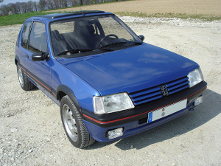The 1.6 GTI was launched in 1984, producing 104 hp, for the 1987 model year the GTI's engine received the cylinder head with larger valves from the 1.9 GTI's engine. The new engine was quoted for 115 bhp. The 1.9 GTI came with an XU9JA engine producing 126 bhp, although later models with a catalytic converter produced 120 bhp. Outside the engine bay the main differences between the 1.6 GTI and the 1.9 GTI are half-leather seats (1.9 GTI) vs. cloth seats (1.6 GTI); and disc brakes all-round (1.9 GTI) vs. discs at the front and drum brakes at the back (1.6 GTI); as well as the 14-inch (360 mm) alloy (Speedline SL201) wheels (1.6 GTI) vs. 15 inch (Speedline SL299) alloys (1.9 GTI).
 The 205 is still often treated as a benchmark in group car tests of the newest GTI models or equivalent. Peugeot itself has never truly recreated this success in future GTI models, although they came very close with the highly regarded GTI-6 variant of the Peugeot 306. A cabriolet version of the 205, known as the CJ (or CT in France), was designed and partially assembled by Pininfarina of Italy. A CTi version, with the same plastic arches and wheels as the 1.6 GTI was also available. Some later models incorporated the catalysed 1.9 engine.
The 205 is still often treated as a benchmark in group car tests of the newest GTI models or equivalent. Peugeot itself has never truly recreated this success in future GTI models, although they came very close with the highly regarded GTI-6 variant of the Peugeot 306. A cabriolet version of the 205, known as the CJ (or CT in France), was designed and partially assembled by Pininfarina of Italy. A CTi version, with the same plastic arches and wheels as the 1.6 GTI was also available. Some later models incorporated the catalysed 1.9 engine.